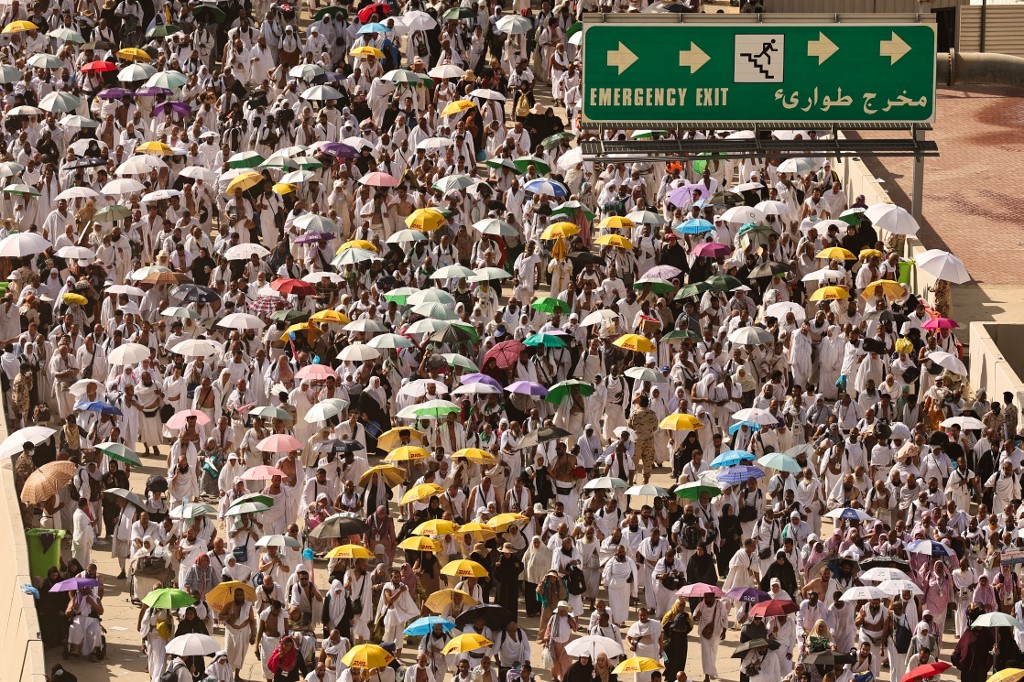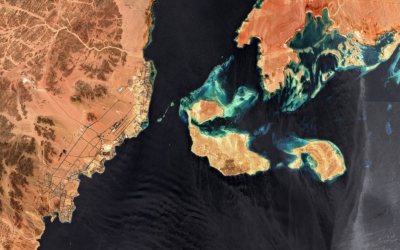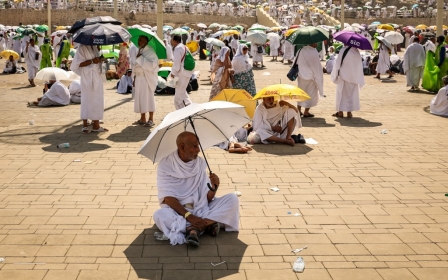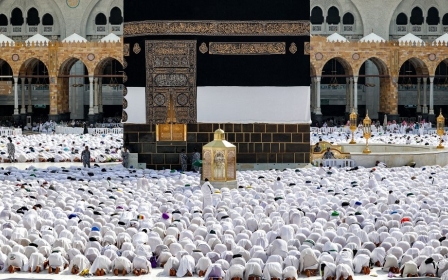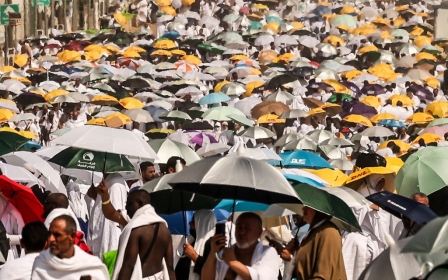Hajj disaster: How more than 1,300 pilgrims died in Saudi Arabia as authorities failed to act
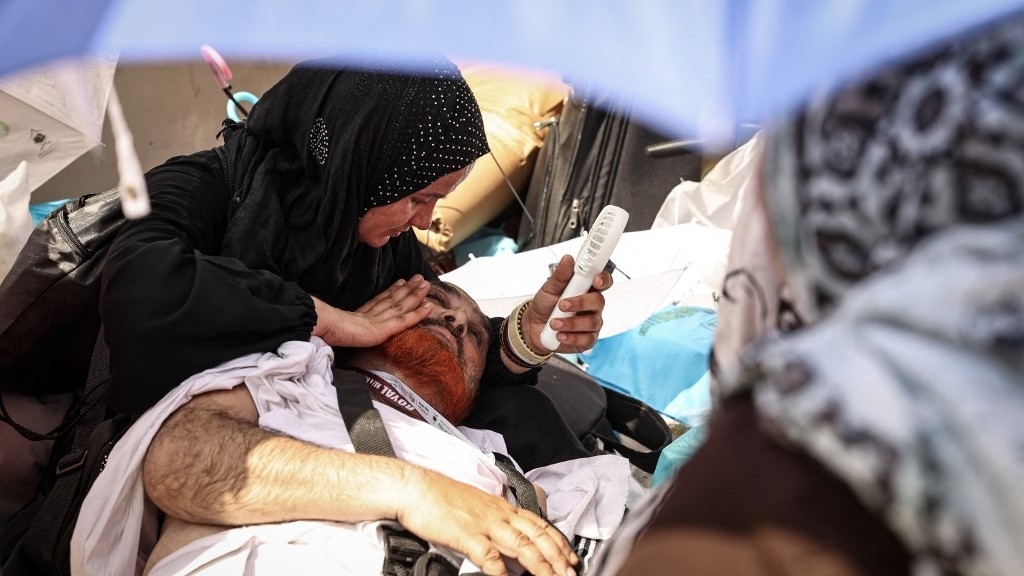
Omar*, an Egyptian in his 40s, considers himself a lucky survivor of Hajj.
More than a thousand people, most of them Egyptians, have died of extreme heat during the annual pilgrimage in Saudi Arabia this month.
Survivors and witnesses say the fatalities were largely avoidable and were the result of negligence by Saudi authorities.
“People were falling around me, and whenever I stopped an ambulance, the paramedics would say they were on their way to save someone else,” Omar, a resident of Saudi Arabia for 20 years, told Middle East Eye from Mecca, after completing the five-day pilgrimage.
MEE spoke with seven Egyptians who performed the Hajj this year. Five of them, including Omar, were registered pilgrims.
New MEE newsletter: Jerusalem Dispatch
Sign up to get the latest insights and analysis on Israel-Palestine, alongside Turkey Unpacked and other MEE newsletters
Approximately 50,000 Egyptians travelled on a Hajj visa this year, organised by the government and its authorised travel agencies.
The survivors, both registered and unregistered pilgrims, said they were barred from boarding buses and forced to walk tens of kilometres under scorching heat, with inadequate facilities, especially emergency medical services.
"We walked for long distances without a single sip of water. On the road to Muzdalifah, I walked three kilometres under the sun, with no resting place or a tree to take shade under,” Omar said.
“When I reached some coolers, I found they had stopped and had no water in them.”
Saudi Arabia on Sunday put the number of people who died from extreme heat at more than 1,300 and said most of them were there illegally.
"Regrettably, the number of mortalities reached 1,301, with 83 percent being unauthorised to perform Hajj and having walked long distances under direct sunlight, without adequate shelter or comfort," the official Saudi Press Agency reported.
The dead came from more than 10 countries ranging from the United States to Indonesia, and some governments are continuing to update their totals.
Arab diplomats told AFP last week that Egyptians accounted for 658 deaths - 630 of them unregistered pilgrims.
The deaths constitute the worst heat-related Hajj disaster in 40 years. In August 1985, around 1,012 pilgrims reportedly died of extreme heat in temperatures exceeding 50 degrees celsius.
'Those who lost consciousness were left behind because they were so many'
- Karim, Egyptian pilgrim
A Saudi security source told MEE that the actual death toll this year might be three to four times higher than reported and that no official comment would be made on these numbers unless the deaths were due to an accident, similar to the 2015 Mina stampede where official figures reported 769 deaths and 694 injuries, while the Associated Press estimated more than 2,121 deaths.
The Saudi government did not respond to requests for comment.
The total distance that pilgrims had to travel between holy sites during Hajj was around 46km, in the period between 14 and 19 June.
Most of the casualties are believed to have taken place on the day of Arafah, the second day of Hajj on 15 June, when pilgrims are required to travel for a distance of about 15km between Mina and the Mount Arafat.
Karim*, an Egyptian pilgrim in his 40s who travelled to Mecca through a smuggler and was there on a business visa, said the number of pilgrims was too many for the authorities to shield from the heat, given the lack of infrastructure and air-conditioned transportation.
“Unfortunately, the security forces were helpless,” he told MEE. “The most they could do was sprinkle water on some of those falling from the heat, and those who lost consciousness were left behind because they were so many."
Puzzling crackdown
A week prior to Hajj, Saudi Arabia announced that its security forces had removed more than 300,000 unregistered individuals from Mecca. A Saudi security source later clarified to MEE that the number surpassed 390,000, with Egyptians making up more than 90 percent.
Seven witnesses and a source within this year's Egyptian Hajj mission confirmed that Saudi security forces launched an unprecedented crackdown in Mecca in the days leading up to Arafah Day on 15 June, aiming to remove all individuals without Hajj permits.
Authorities announced that anyone without a Hajj badge or a work permit would be barred from Mecca. Witnesses reported raids and arrests in hundreds of residences, particularly in the Al-Aziziyah district.
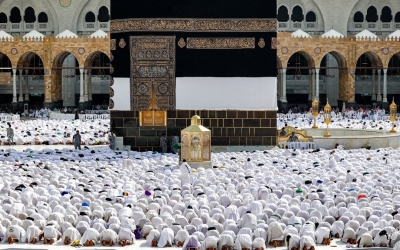
Everything in Mecca was tied to this badge during Hajj, even grocery stores and restaurants required it before providing services.
According to the Ministry of Hajj and Umrah, the Hajj badge is an identification card, called the Nusuk Card, that allows pilgrims access to all sacred sites and services. It must be carried throughout the Hajj period from arrival to departure. In addition to identity details, the smart card provides information about the person’s health record, place of accommodation during Hajj and contact information for their group’s leader.
According to all witnesses who spoke to MEE, Saudi security forces unexpectedly allowed all unauthorised individuals to enter Mecca and head towards Mina just hours before the long trek to Arafat. The intense arrest campaigns suddenly ceased for unknown reasons.
A tragedy then unfolded, when pilgrims started to move from Mina to Arafat, a distance of approximately 15km (9 miles).
Pilgrims can usually complete the journey using buses designated for Hajj. However, unauthorised pilgrims were not allowed to board buses, and many with Hajj badges also found no transportation to Arafat after being abandoned by travel agencies.
This left tens of thousands walking at least 15km in one day under direct sunlight and temperatures nearing 50 degrees celsius.
Hundreds collapsed on the way, a situation that repeated itself on the return journey from Arafat to Muzdalifah, then from Muzdalifah to Mina, and finally to Mecca.
Karim, who did not have a Hajj badge, told MEE he paid 1,000 riyals ($267) to someone to give him a car ride into Mecca from Taif (about 75km away) where he had arrived four days before Arafah Day.
'The ministry allocates buses based on the number of registered pilgrims only'
- Official, Hajj ministry
“Despite paying the mediators for a bus ride to Arafat, the bus never arrived, forcing me and my group to walk 27km to Mount Arafat,” he said.
“Three members of my group died during the walk, including a 45-year-old man,” he added.
Another witness, who held a Hajj badge and was part of a “VIP package” group paying a travel agency twice the amount of regular pilgrims, described the poor services despite their high cost.
“The bathroom facilities were particularly inadequate, and when we complained, we were told that the sewage infrastructure was insufficient because it’s only used for one day each year,” he told MEE.
“Also, food and drink distribution was largely left to the pilgrims themselves.”
One witness reported that drinking water and juices were significantly lower this year than previous years, as were emergency services and public water sprinklers, despite the number of pilgrims being much lower than in past years.
Saudi Arabia announced that the number of pilgrims this year was 1.833 million, compared with 3.2 million in October 2012, when the total death toll was 1,315.
A Saudi source from the bus oversight authority in the Ministry of Hajj and Umrah blamed unregistered pilgrims and tourism companies for the unavailability of bus rides.
“The ministry allocates buses based on the number of registered pilgrims only, and no buses were assigned for unregistered pilgrims,” the source said. “Some of the unregistered pilgrims took the places of legitimate pilgrims, leading to chaos.”
Surge in irregular pilgrims
In 2019, the Saudi government introduced new types of visas, including an electronic visa system for foreign visitors to attend sporting events and concerts, as part of its efforts to attract event tourism, diversify its economy, and open up its society.
Omar, the Egyptian resident of Saudi Arabia who performed Hajj this year and last year, said that the surge in unregistered pilgrims can be attributed to the new, easy-to-obtain entry visas.
Initially, tourism companies were hesitant to exploit this system for fear of legal consequences or a ban on performing Hajj. However, they were surprised when Saudi authorities allowed pilgrims who arrived on a non-Hajj visa to perform Hajj smoothly without any obstacles or penalties.
This emboldened the companies to expand this practice to hundreds of thousands outside the regular Hajj quota system only available for a limited number of people every year. The phenomenon also surged due to the rising Hajj costs in Egypt after multiple devaluations of the Egyptian currency in recent years.
Egyptian and Saudi sources, along with witnesses, unanimously agreed that the decision to allow unregistered pilgrims into Mecca before Arafah Day was extremely puzzling. They questioned why these pilgrims were allowed to enter and proceed to Arafat, yet were denied bus rides and received minimal services, suggesting it was a form of punishment.
Rumours circulated among the Egyptian pilgrims that the unauthorised Egyptians were allowed into Mecca before heading to Arafat due to intervention by Egyptian President Abdel Fattah el-Sisi, who was also performing Hajj.
Neither the Egyptian presidency nor the ministry of foreign affairs responded to requests for comment.
A source from Egypt’s foreign ministry stated that a team from the prime minister’s office had travelled to Saudi Arabia to investigate the matter.
The Egyptian cabinet on Saturday issued a decision to revoke the licences of 16 tourism companies, impose fines to be paid to the families of the deceased, and refer the company officials to the public prosecutor. The companies were accused of circumventing the regulations to send pilgrims illegally.
* Names changed for security reasons.
Middle East Eye delivers independent and unrivalled coverage and analysis of the Middle East, North Africa and beyond. To learn more about republishing this content and the associated fees, please fill out this form. More about MEE can be found here.



